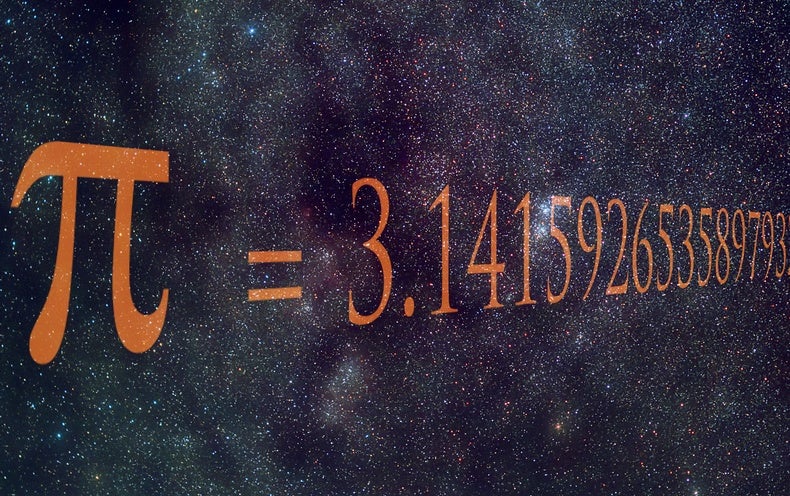
At least 3,700 years ago, Babylonian mathematicians approximated the ratio of a circle’s circumference to its diameter. They inscribed their answer, the first discovered value of pi, on a humble clay tablet: 25/8, or 3.125. Now Carl-Johan Haster, a theoretical astrophysicist at the Massachusetts Institute of Technology, has managed to do almost as well: in a study uploaded to the preprint server arXiv.org, he measured pi to be about 3.115.
In the intervening years, researchers have calculated the true value of the ratio to a modest 50 trillion decimal places with the aid of powerful computers (you probably know how it starts: 3.141592653… and on into infinity). Haster’s approximation of it may be a couple of millennia behind in terms of accuracy, but that fact is of little relevance to his real goal: testing Einstein’s general theory of relativity, which links gravity with the dynamics of space and time.
Information about the laws of physics is effectively baked into gravitational waves, the ripples in spacetime created when massive objects such as black holes spiral into one another. Haster, a member of the Laser Interferometer Gravitational-Wave Observatory (LIGO) Scientific Collaboration, noticed pi appeared in several terms of an equation describing the waves’ propagation.
“What Carl did was say, ‘Look, all of these coefficients depend on pi. So let’s change pi, and let’s check whether the measurements are consistent [with general relativity],’” says Emanuele Berti, a theoretical physicist at Johns Hopkins University, who was not involved in the new study and is not part of the LIGO collaboration.
Haster realized that he could treat pi as a variable instead of a constant. Then he could check the equation for gravitational waves against LIGO’s experimental measurements of them. Einstein’s theory should have matched the measurements if and only if Haster used values of pi close to that already determined by other methods. If general relativity matched LIGO’s measurements when pi was not close to its true figure, that would be a sign that the theory was only half-baked. By trying values of pi from –20 to 20, Haster checked more than 20 observed candidate gravitational-wave eventsand found that the figure that matched theory to experiment was about 3.115. So Einstein’s recipe does not seem to need any tweaking just yet. “In my head, at least, [the study] has a nice mix of being both kind of cute and amusing and also actually producing a valid and fairly strong test of general relativity,” Haster says.
Pi seems to pop up all the time—not just explicitly in circles but in the hydrogen atom and the way needles fall across lines. The reason a factor of pi appears in an equation for gravitational waves is a little headier, however: the waves interact with themselves.
“When a gravitational wave is traveling out, it sees the the curvature of spacetime, including the energy that was generated by the gravitational waves produced in the past,” Berti says. The first stone you drop into a calm pond sends out smooth ripples across the surface. If you drop another stone immediately after, the surface is no longer smooth—leftover ripples from the previous stone will interfere with new ripples from the second one. Gravitational waves work similarly, but the medium is spacetime itself, not water.
The equation describing this self-interacting effect contains factors of pi as a piece of several numerical terms. A previous examination of Einstein’s theory by LIGO in 2016 varied individual terms instead of slicing out a common factor across several terms such as pi. Although this approach sufficed as a test of general relativity, physicists have wanted to see all the terms changing together, and Haster’s method using pi offers a way of doing just that.
But it remains a far from transcendental test of the theory. One issue is the relative uncertainty of Haster’s figures: his approximation of pi currently ranges from 3.027 to 3.163. Significantly sharpening it will require observing mergers of lighter objects such as neutron stars, which create drawn-out gravitational waves that can last 300 times longer than those from a colliding pair of massive black holes. Like trying to identify an unknown song, the more one can listen, the better. Currently, there are only two recorded confirmed neutron star mergers in the available data. And until LIGO—which is shut down because of COVID-19—resumes operations, that number will not change.
Not everyone is worried about the flakiness of this pi-scrying technique, though. “Many people have been discussing the fact that we could maybe change Pi Day (March 14) into ‘Pi Two Weeks’ (March 2 to March 15) to account for current uncertainty,” jokes Chris Berry, an astrophysicist at Northwestern University, who was not involved in the new study and is part of the LIGO collaboration.
This proposal would, of course, likely increase the number of pastries for a pi-loving physicist to consume. But Berry maintains that calorie increase would not be altogether a bad thing. A fortnight of feasting, he says, would eventually give researchers another way to approximate pi: measuring their own rotund circumference.
"general" - Google News
May 19, 2020 at 07:14PM
https://ift.tt/2WHQd6q
Pi in the Sky: General Relativity Passes the Ratio's Test - Scientific American
"general" - Google News
https://ift.tt/2YopsF9
https://ift.tt/3faOei7
Bagikan Berita Ini














0 Response to "Pi in the Sky: General Relativity Passes the Ratio's Test - Scientific American"
Post a Comment